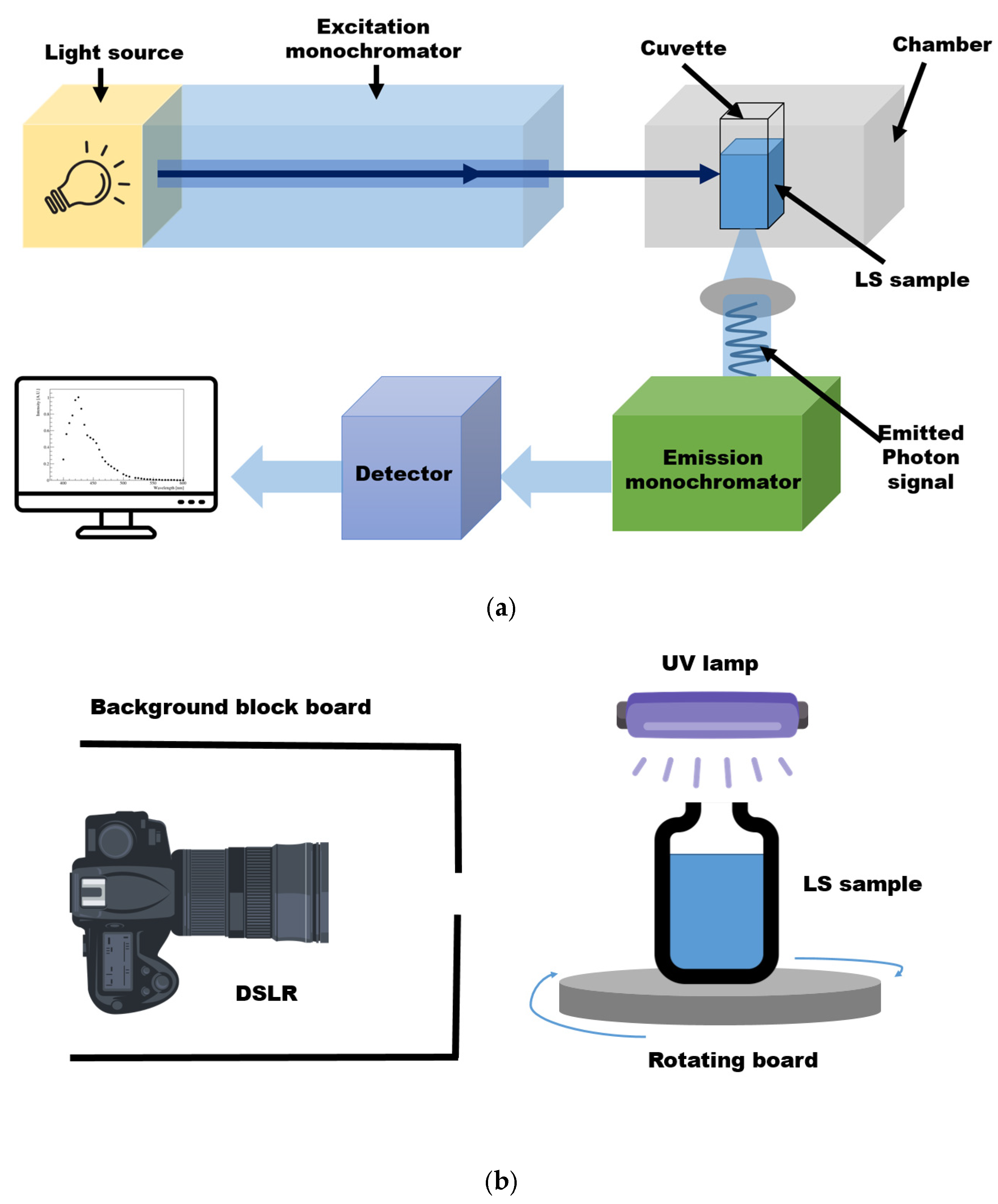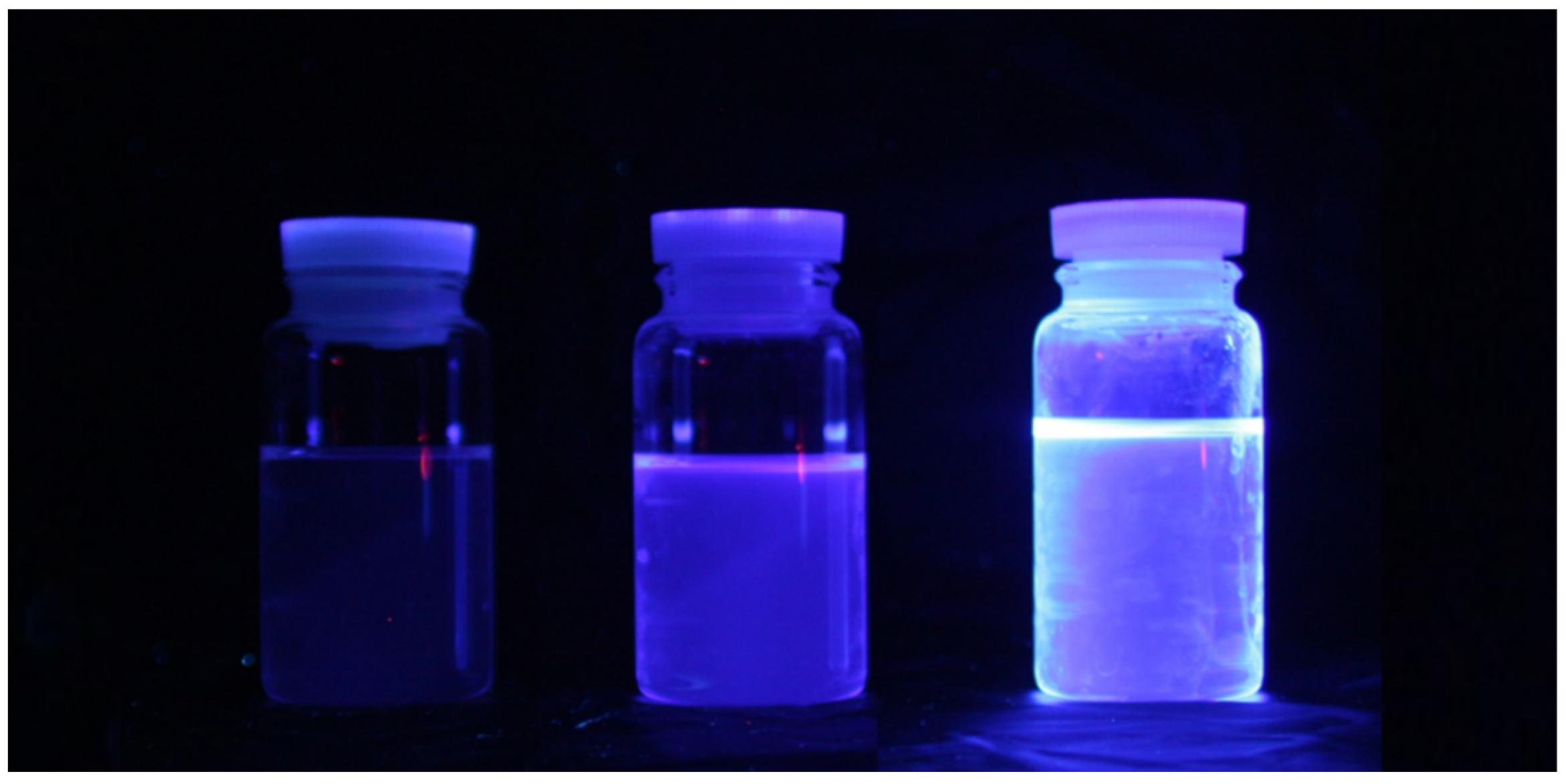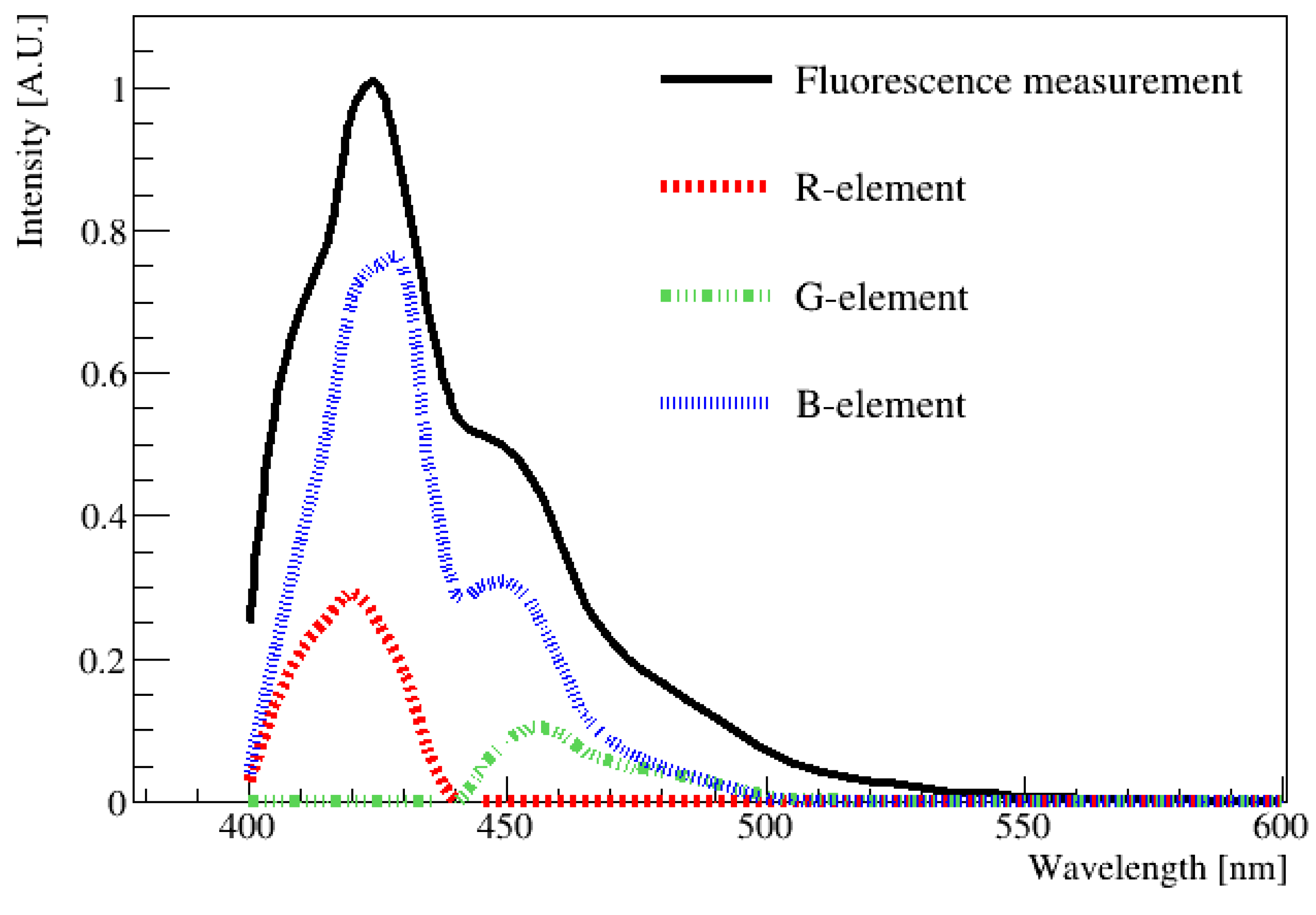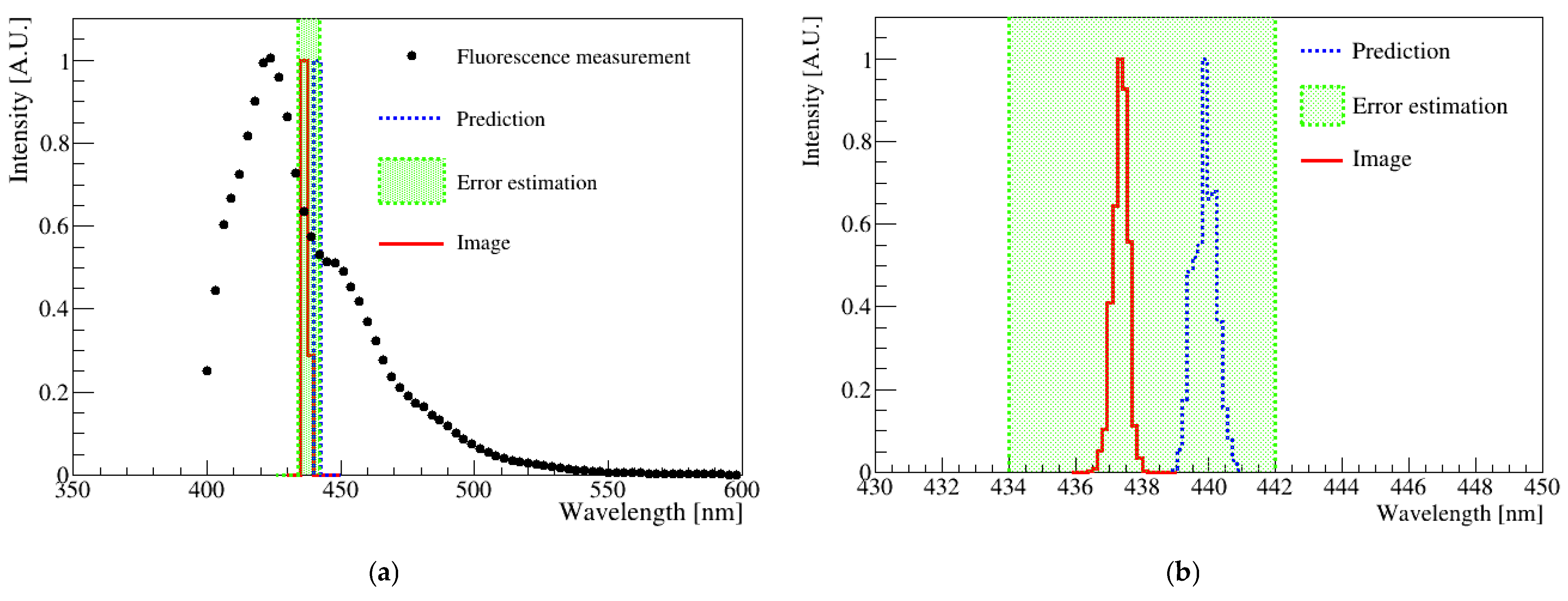Estimating Fluor Emission Spectra Using Digital Image Analysis Compared to Spectrophotometer Measurements
Abstract
:1. Introduction
2. Measurement of Light Emissions from an LS Sample
2.1. Experimental Setup

2.2. H-W Relationship Using an LED
2.3. Comparison of Results Obtained Using Spectrophotometer and a Digital Image
3. Summary
Author Contributions
Funding
Institutional Review Board Statement
Informed Consent Statement
Data Availability Statement
Conflicts of Interest
References
- Alimonti, G. Light propagation in a large volume liquid scintillator. Nucl. Instrum. Methods Phys. Res. Sect. A 2000, 440, 360–371. [Google Scholar] [CrossRef]
- Ding, Y.; Zhang, Z.; Liu, J.; Wang, Z.; Zhou, P.; Zhao, Y. A new gadolinium-loaded liquid scintillator for reactor neutrino detection. Nucl. Instrum. Methods Phys. Res. Sect. A 2007, 522, 238–243. [Google Scholar] [CrossRef]
- Park, K.S.; Park, J.S.; Kim, B.C.; Shin, J.W.; Ahn, J.K. Construction and properties of acrylic vessels in the RENO detector. Nucl. Instrum. Methods Phys. Res. Sect. A 2012, 686, 91–99. [Google Scholar] [CrossRef]
- Suekane, F. An overview of the kamland 1-kiloton liquid scintillator. arXiv 2004, arXiv:0404071v2. [Google Scholar]
- Winn, D.R.; Raftery, D. Water Based Scintillators for Large Scale Liquid Calorimetry. IEEE Trans. Nucl. Sci. 1985, 32, 727–732. [Google Scholar] [CrossRef]
- Yeh, M.; Hans, S.; Beriguete, W.; Rosero, R.; Hu, L.; Hahn, R.L.; Diwan, M.V.; Jaffe, D.E.; Kettell, S.H.; Littenberg, L. A New Water-Based Liquid Scintillator and Potential Applications. Nucl. Instrum. Methods Phys. Res. Sect. A 2011, 660, 51–56. [Google Scholar] [CrossRef]
- Fischer, V.; Tiras, E. Water-based Liquid Scintillator Detector as a New Technology Testbed for Neutrino Studies in Turkey. Nucl. Instrum. Methods Phys. Res. Sect. A 2020, 969, 163931. [Google Scholar] [CrossRef]
- So, S.H.; Joo, K.K.; Kim, B.R.; Kim, B.C.; Kim, S.C. Development of a Liquid Scintillator Using Water for a Next Generation Neutrino Experiment. Adv. High Energy Phys. 2014, 2014, 327184. [Google Scholar] [CrossRef]
- Guide to Spectrometry for R&D: Mass Spectrometers Infrared Spectrometers UV-Vis Spectrometers X-ray Spectrometers. R ND D–NEWTON. 2010, Volume 52. No 2. (in press). Available online: http://www.riss.kr/search/detail/DetailView.do?p_mat_type=e21c2016a7c3498b&control_no=05b25fcdd9b57472ffe0bdc3ef48d419&keyword=Guide%20to%20Spectrometry%20for%20R&D%20Newton (accessed on 23 April 2023).
- Smith, T.; Guild, J. The CIE colorimetric standards and their use. Trans. Opt. Soc. 1931, 33, 73–134. [Google Scholar] [CrossRef]
- Smith, A.R. Color Gamut Transform Paris. ACM Siggraph Comput. Graph. 1978, 12, 12–19. [Google Scholar] [CrossRef]
- Chernov, V.; Alander, J.; Bochko, V. Integer-based accurate conversion between RGB and HSV color spaces. Comput. Electr. Eng. 2015, 46, 328–337. [Google Scholar] [CrossRef]
- Gonzalez, R.C.; Woods, R.E. Digital Image Processing; Pearson: London, UK, 2018. [Google Scholar]
- Wang, Z.L. CorTector™ SX100: Principles and applications of a bench-top fluorescence correlation spectrometer. Prog. Biochem. Biophys. 2018, 45, 1166–1177. [Google Scholar]
- Ramanath, R.; Snyder, W.E.; Bilbro, G.L. Demosaicking methods for Bayer color arrays. J. Electron. Imag. 2002, 11, 306–315. [Google Scholar] [CrossRef]
- Gunturk, B.K.; Glotzbach, J.; Altunbasak, Y.; Schafer, R.W.; Mersereau, R.M. Demosaicking: Color filter array interpolation. IEEE Signal. Process. Mag. 2005, 22, 44–54. [Google Scholar] [CrossRef]
- Mavrodineanu, R. An Accurate Spectrophotometer for Measuring the Transmittance of Solid and Liquid Materials. J. Res. Natl. Bur. Stand A Phys. Chem. 1972, 76A, 405–425. [Google Scholar] [CrossRef] [PubMed]
- Sebestyen, I.; Mitchell, J.L.; Ono, F. The First Joint ITU ISO/IEC Still Image Compression Standards. 2005. Available online: https://www.itu.int/ITU-T/worksem/vica/docs/presentations/S4_P1_Sebestyen.pdf (accessed on 23 April 2023).
- What Is the Difference between Spectrophotometer and Spectrofluorometer. Available online: https://www.differencebetween.com/what-is-the-difference-between-spectrophotometer-and-spectrofluorometer/ (accessed on 17 January 2023).
- Teikari, P.; Najjar, R.P.; Malkki, H.; Knoblauch, K.; Dumortier, D.; Gronfier, C.; Cooper, H.M. An inexpensive Arduino-based LED stimulator system for vision research. J. Neurosci. Methods. 2012, 211, 227–236. [Google Scholar] [CrossRef]
- Monika, D.; Neetu, S. A Fast HSV Image Color and Texture Detection and Image Conversion Algorithm. Int. J. Sci. Res. 2014, 3, 1279–1284. [Google Scholar]
- Park, H.W.; Choi, J.W.; Choi, J.Y.; Joo, K.K.; Kim, N.R. Investigation of the Hue–Wavelength Response of a CMOS RGB-Based Image Sensor. Sensors 2022, 22, 9497. [Google Scholar] [CrossRef] [PubMed]






| Wavelength (nm) | R | G | B |
|---|---|---|---|
| 400 | 111 | 0 | 154 |
| 410 | 103 | 0 | 180 |
| 420 | 85 | 0 | 206 |
| 430 | 55 | 0 | 230 |
| 440 | 0 | 0 | 255 |
| 450 | 0 | 70 | 255 |
| 460 | 0 | 122 | 255 |
| 470 | 0 | 169 | 255 |
| 480 | 0 | 213 | 255 |
| 490 | 0 | 255 | 255 |
| 500 | 0 | 255 | 146 |
| 510 | 0 | 255 | 0 |
| 520 | 53 | 255 | 0 |
| 530 | 93 | 255 | 0 |
| 540 | 129 | 255 | 0 |
| 550 | 162 | 255 | 0 |
| 560 | 194 | 255 | 0 |
| 570 | 225 | 255 | 0 |
| 580 | 255 | 255 | 0 |
| 590 | 255 | 223 | 0 |
| 600 | 255 | 190 | 0 |
Disclaimer/Publisher’s Note: The statements, opinions and data contained in all publications are solely those of the individual author(s) and contributor(s) and not of MDPI and/or the editor(s). MDPI and/or the editor(s) disclaim responsibility for any injury to people or property resulting from any ideas, methods, instructions or products referred to in the content. |
© 2023 by the authors. Licensee MDPI, Basel, Switzerland. This article is an open access article distributed under the terms and conditions of the Creative Commons Attribution (CC BY) license (https://creativecommons.org/licenses/by/4.0/).
Share and Cite
Park, H.-W.; Choi, J.-W.; Joo, K.-K.; Kim, N.-R.; Shin, C.-D. Estimating Fluor Emission Spectra Using Digital Image Analysis Compared to Spectrophotometer Measurements. Sensors 2023, 23, 4291. https://doi.org/10.3390/s23094291
Park H-W, Choi J-W, Joo K-K, Kim N-R, Shin C-D. Estimating Fluor Emission Spectra Using Digital Image Analysis Compared to Spectrophotometer Measurements. Sensors. 2023; 23(9):4291. https://doi.org/10.3390/s23094291
Chicago/Turabian StylePark, Hyeon-Woo, Ji-Won Choi, Kyung-Kwang Joo, Na-Ri Kim, and Chang-Dong Shin. 2023. "Estimating Fluor Emission Spectra Using Digital Image Analysis Compared to Spectrophotometer Measurements" Sensors 23, no. 9: 4291. https://doi.org/10.3390/s23094291
APA StylePark, H.-W., Choi, J.-W., Joo, K.-K., Kim, N.-R., & Shin, C.-D. (2023). Estimating Fluor Emission Spectra Using Digital Image Analysis Compared to Spectrophotometer Measurements. Sensors, 23(9), 4291. https://doi.org/10.3390/s23094291





